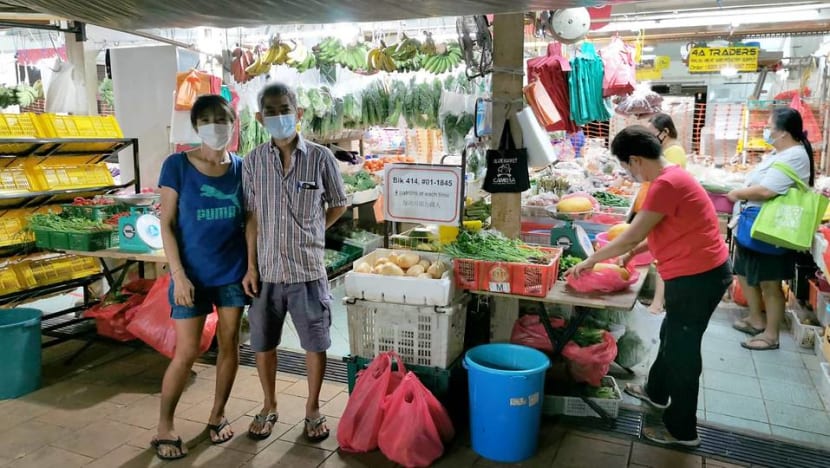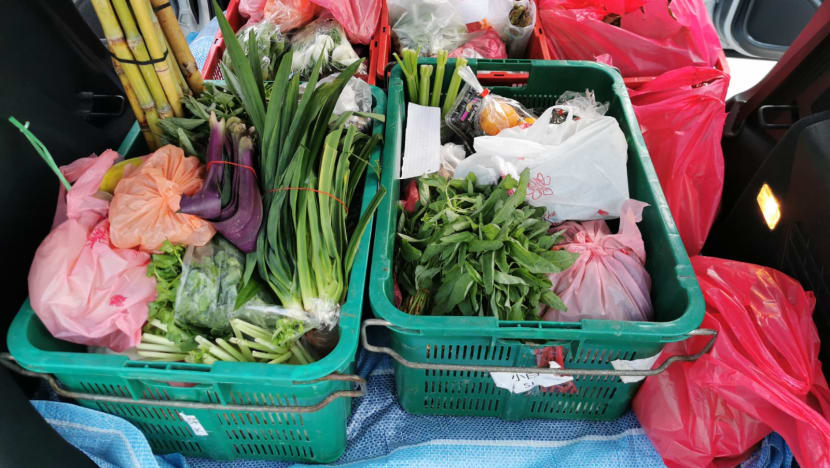COVID-19 drives more wet market stalls online, but will they be here to stay?

Going online gave this wet market stall at Geylang Serai Market a much-needed boost after business took a hit from the "circuit breaker" rules. But while it fulfills 30 to 40 online orders a day now, its owners are unsure if this demand will be sustained. (Photo: Alfred Goh)
SINGAPORE: With fewer customers at Geylang Serai Market and restaurants cutting back orders by as much as 90 per cent almost immediately after the “circuit breaker” rules kicked in, business slowed so much that Mr Alfred Goh and his father found themselves with more than 100kg of shellfish left unsold one day.
Feeling anxious about the leftovers which would have to be discarded by the end of the day, the younger Goh went on Facebook to ask if there were any takers.
The response was unexpected - 500 orders and more than 3,000 shares for his Facebook post in a matter of hours. As he worked through the orders, Mr Goh began wondering if he should take his father’s 40-year-old wet market business online.
“That was the most surprising thing and it hit me that there’s a huge demand for home delivery of fresh products,” he told CNA.
READ: Tekka market stalls turn to live-streaming to sell fresh produce, as people stay home amid COVID-19
Mr Goh, whose own debate coaching business has also been disrupted by COVID-19 with schools closed for now, decided to give it a shot.
One month on, Guang’s Fresh Mart has its own website and Facebook page, and fulfils about 30 to 40 online orders a day.
WET MARKET TO WEB MARKET
The Gohs are among the many business owners who have had to start selling online and offer deliveries to keep operating amid the circuit breaker period.
Many in the traditional wet markets have done so with help from the younger, tech-savvy generation in the family. Facebook is usually the first port of call. Apart from creating individual pages to take orders, there is also a Facebook group called the Pasar United –Dabao 2020, which allows stall owners to promote their products and delivery services for free.
Authorities have also organised live-streaming sessions for those from Tekka Market to venture online. The first run held last week saw almost all of the participating stalls selling out their items.
Way before the virus outbreak, there were wet market stalls that took the leap to go online. And these early movers have since seen a surge in orders as consumers staying home seek alternatives to stock up on their daily essentials.
READ: Delivery slots run dry as more turn to online grocery shopping amid COVID-19 concerns
Orders on Tankfully Fresh, the online arm of wet market seafood stall Sin Chwee Mini Market in Bukit Batok, jumped by more than 80 per cent “instantly” after the circuit breaker was announced.
The spike in orders began even earlier for MarketFresh, which was launched in 2017 and sources wet market produce from 14 stalls at Tiong Bahru Market.
“The surge started from when the Government announced DORSCON Orange. We are handling triple the volume that we used to handle daily,” its founder Khor Chin Puang told CNA.
CHALLENGES COPING WITH DEMAND
This surge in demand can be overwhelming.
“Every facet of our fulfilment process has bucketed under the initial explosion in demand,” said Mr Khor, who added that the platform’s sorting, packing and delivery processes were not designed for such high volumes.
To cope, MarketFresh has outsourced most deliveries to third-party couriers, temporarily reduced its offerings to streamline packing and put a daily cap on orders.
It has, however, opened up additional delivery slots to those who “really require” its services, said Mr Khor. These include families serving quarantine orders or stay-home notices, as well as people who live overseas but want to order for their elderly parents in Singapore.
Mr Jimmy Goh, owner of Tankfully Fresh, cited a manpower shortage as its main challenge. The platform taps third-party couriers for deliveries but has been “slowly” recruiting its own deliverymen.

For smaller new entrants, the move online can often be a one-man-show.
Ms Tan Cheng Hwee has been taking orders through a Google spreadsheet, packing them, planning delivery routes and making the deliveries all by herself since taking to Facebook to promote her family’s wet market stall, Swee Seng Fruits & Veggies, three weeks ago.
The online orders, which ranged from S$30 to S$80, have helped to reduce leftovers at the stall.
Ms Tan said her father had always wanted to offer home deliveries, but the plan never materialised as Ms Tan and her brother were busy with their job and studies. There were also doubts about going up against major supermarket chains and RedMart in the grocery delivery space.
It was only after COVID-19 disrupted the family business and her own freelance work in the film and television industry that the 27-year-old, with encouragement from her cousins, set the wheels in motion.
There have been challenges, such as how to take orders more efficiently. Ms Tan started off by accepting orders via WhatsApp until one of her cousins did up an online spreadsheet.
There is also a limit in terms of how many orders she can deliver a day. For efficiency, online orders are now grouped according to locations, which means she has had to turn down those that are out of the way.
“Given that we just started, I have to say that if we get more (orders), I might get quite swamped but I’m learning how to manage and get better,” said Ms Tan.

STOP-GAP MOVE OR HERE TO STAY?
Wet market stallholders believe that their competitive edge lies in offering fresher produce. While COVID-19 has given them a push to go online, the new entrants said they have not decided if this is for the long run.
Several issues remain. For instance, will the current surge in demand be sustained?
Mr Goh reckons that demand could drop between 50 and 70 per cent once the circuit breaker ends. “But some friends and family are optimistic that people will still appreciate fresh seafood delivered to their homes so we have to monitor, and just try to see if and how the business can remain sustainable," he added.
READ: Changing the face of the wet market to appeal to new customers
Both Mr Goh and Ms Tan also have plans to return to their jobs eventually, so manpower could be an additional cost to consider should their parents decide to keep accepting orders online.
As MarketFresh’s Mr Khor pointed out: “The biggest challenge I feel is not technical, but economical. How do we deliver our produce to customers but still do it at a profit after considering fulfilment and delivery costs?”
But that should not stop traditional businesses from digitising, and Mr Khor suggested tapping existing online platforms as a starting point. MarketFresh, for example, used e-commerce platform Shopify to set up its online store.
“Nothing we build ourselves can come close to the functionality that established platforms can offer,” he said.
“If you want to simplify the process even further, you can make use of platforms like Facebook Live. There is little to no programming required, though the downside is scalability as most of the fulfilment processes like order taking and payment are still done manually.”
In Mr Goh’s case, he had tapped local start-up Ezqr at the start before recently moving on to Shopify. To see how he can further develop his father’s business, he is mulling signing up with Grab’s grocery delivery service, GrabMart.
Grab has approached many wet market stall owners in recent weeks, said Mr Goh who noted that the tech firm offers access to new customers and ease of delivery. The only drawback is the steep commission fees, which range from 15 per cent per order if merchants do their own deliveries and 30 per cent otherwise.
“Fresh grocery is not something you can mark up (prices) and given that we are not a high-margin business, even 15 per cent can be insane,” he said.
“But reach is also important and if I can acquire more customers than I could have otherwise, then it may not be a bad thing.”
READ: As COVID-19 hits F&B sector, calls emerge for delivery apps to lower commission fees
READ: Any legislation to cap commission fees of delivery apps has to be ‘carefully’ considered: Chee Hong Tat
A spokesperson from Grab said there are currently “a few hundred” merchants on board GrabMart, offering fresh produce, health and wellness products, flowers and gifts, as well as snacks.
The grocery delivery service started last October with “a small range” of convenience and wellness brands, such as Cheers and FairPrice Xpress. To meet changing needs brought about by COVID-19, it has been expanding its assortment, merchant selection and coverage.
“Now more than ever, we are seeing a strong demand for fresh produce, especially fruits and vegetables. We are already working with a number of merchants to meet this demand – these could include provision shops as well as vendors located in wet markets,” said the spokesperson, who added that “a small number of stalls from wet markets” have since joined the platform.
Grab declined to reveal its commission rates but said these vary based on the type of collaboration it has with its merchants.
“We are constantly listening to the merchants’ feedback, and will continue to explore more ways to create value for them as well as the customers,” the spokesperson said.
BOOKMARK THIS: Our comprehensive coverage of the coronavirus outbreak and its developments
Download our app or subscribe to our Telegram channel for the latest updates on the coronavirus outbreak: https://cna.asia/telegram















